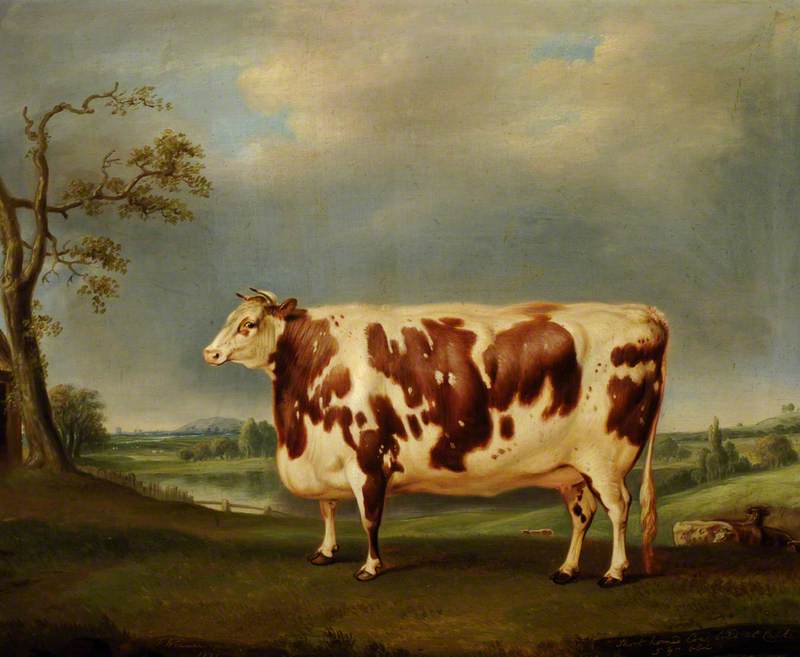by The Curious Scribbler
In my last entry I reflected upon the phenomenon whereby volunteer organisations seem to be prone to particularly vicious in-fighting.
Seeking respite from the present I found myself in the library looking for evidence of the long-deceased animal painter, Thomas Weaver 1774–1843. Weaver painted handsome four square portraits of sheep and cattle with tiny heads and a sturdy leg at each corner. Unpublished correspondence also shows that Col Phelp of Coston, the father of Laura Powell of Nanteos, would have liked to get Weaver, who lived at Shrewsbury, to paint his daughters. I did not find any evidence that he actually did so, but, through one of those plausible false alarms I found myself reading the obituary of another gentleman of the same name, a certain Thomas Weaver who died in 1852, who appears in a bound collection of published sermons on microfilm at the National Library of Wales. This Thomas Weaver, who was buried at Shrewsbury had served as a clergyman for 53 years.
Much of the sermon was to, 21st century readers, almost intelligible, drawing upon references to very obscure aspects of the old testament, and with a fine rolling oratorial style which made it even more difficult to follow.
However when we got to the biographical part it was far more illuminating.
He obtained his ministerial education at Hoxton College in London: and upon receiving a cordial invitation from the church assembling in this place he settled among them as their pastor in the year 1798: not, however, till after some hesitation about such a step, arising from the depressed nature of the congregation, and the somewhat repulsive aspect, spiritually viewed, of some of its members. His decision seems to have been made under the advice of a ministerial friend, who, in reference to some of those who were least attractive to him, quaintly and quietly said ” Death will soon help you there”.
His ministry, commenced under such disadvantageous circumstances, proved, by the blessing of God, successful.
Did the funeral congregation allow themselves an approving chuckle at this ‘quaint and quiet counsel’? We seem to be far more reluctant, these days, to publicly count our future blessings in the form of the anticipated death of those of whom we disapprove. How, after all, could the Revd Thomas Weaver be confident that the population of Hoxton would not be swelled by an equal number younger and healthier, yet equally spiritually repulsive individuals, perhaps even the spawn of his old adversaries?
Judged with hindsight, it seems to me that to leave posterity with a really nice portrait of a foursquare cow is probably a more enduring form of immortality than ministering to the residents of Hoxton.


I love this cow portrait – just love it!
The counsel offered brought to mind a quote from the bible that my mother regularly used when she would say to me, this trial or tribulation–whatever it was that was presenting itself to her–too will pass.
Doug J.
Malcolm Cormack in his Country Pursuits: British, American, and French Sporting Art from the Mellon Collections in the Virginia Museum of Fine Arts (Virginia Museum of Fine Arts, Richmond, in association with University of Virginia Press, Charlottesville and London, 2007) writes about Thomas Weaver (ca. 1774-1843) and his oil painting ‘Two Durham Oxen’ (1827), owned by a Staffordshire man. They weighed 2,742 and 2,437 pounds. He says there was a steady market for prints of prize livestock, which were specially bred to win prizes at agricultural shows, mostly for their immense size and unhealthy weight, in rivalry with neighbouring estates. He give the later history of the land at the village of Tixhall, near Stafford.
No copy in the National Library as far as I can see but I have one if you would like to see it.
Thanks for the comment – it certainly explains the slightly weird proportions of these animals. No I don’t need the copy of Cormack’s book, I was only drawn into the world of Thomas Weaver by another scholar, Lawrence Weaver, a descendant, who is working on a biography of Weaver. Serendipitously he turned up a connection between Weaver and Nanteos. William Edward Powell’s wife Laura, and his father-in-law Colonel James Phelp corresponded with Weaver and his wife Susannah. More on Nanteos in due course.